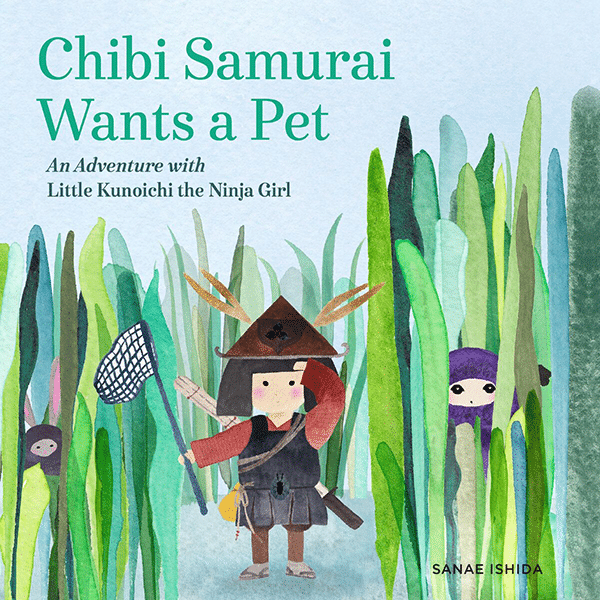
Chibi Samurai Wants a Pet
- Fiction
- Set in Japan
Keywords: humor, ninja, nature, exploration
This is the second in a creative series featuring Little Kunoichi the Ninja Girl and her friend, Chibi Samurai. Author and illustrator Sanae Ishida creates whimsical, engaging characters to lead young readers into Japanese culture. Clues to traditional games and toys, folktales and legends, musical instruments, and pastimes such as collecting insects are hidden throughout the watercolor illustrations. Children will love the humorous text, and a guide at the end, “Did you know,” offers practical information.
Overview
Sanae Ishida’s Chibi Samurai Wants a Pet follows Chibi (pronounced: CHEE-bee), a little samurai, on his quest through a magical land to find a pet. Inspired by his friend Little Kunoichi (pronounced: coo-NO-ee-chee) and her spectacular pet Ninja Bunny, Chibi sets off to find a companion of his own. As Chibi explores his world, he finds a variety of animals and mythical creatures that he considers for his pet, each with its own pros and cons. After encountering many setbacks on his journey, Chibi ultimately finds the perfect companion while learning an important life lesson on the way.
Background
Chibi Samurai Wants a Pet effectively introduces many elements of Japanese culture. The protagonist, Chibi, is a samurai, which is an overarching term for the different ranks of warriors in Japan from around the twelfth century up until the Meiji Restoration in 1868. During the late nineteenth century, the samurai class was abolished as one of many steps to modernize Japan. In their heyday, lower levels of samurai served as loyal retainers of powerful military lords, or daimyo (pronounced: DIE-me-yoh). The terms samurai and bushi(pronounced: BOO-shee) are often used interchangeably.
Chibi’s name itself is a cultural reference. The word chibi refers to a style of character drawing where the subject is pictured as exceptionally small; the term is also used to refer to someone who is short or little, and it implies cuteness. Chibi characters are typically short and chubby. They have small limbs, and many have large, round eyes. Unlike Chibi Samurai, chibi characters are not always children. In current pop culture, teen and adult anime and manga characters are often drawn in a chibi style.
Chibi’s friend Little Kunoichi also has a cultural reference in her name. Little Kunoichi is a ninja in training. In premodern Japan, ninja were typically farmers from specific clans who were hired by daimyo for clandestine operations. Contrary to popular belief, ninja were not primarily assassins; rather, they engaged in espionage, sabotage, and intelligence gathering for feudal lords. Most ninja were thought to be men, yet there is debate about whether or not female ninja, called kunoichi, ever existed. According to most scholars, the term kunoichi simply referred to women in general. However, the idea of kunoichi as female ninja has become widespread, and the term now carries the general meaning of “ninja woman.”
Chibi’s adventure revolves around finding a pet as amazing as Ninja Bunny. Several of the creatures he encounters come from Japanese folklore. For example, he finds a tanuki (pronounced: TAH-new-key), or raccoon-dog, a trickster figure that can transform into anything. Tanuki are a real animal found in Japan (Nyctereutes procyonoides viverrinus), but their folkloric counterpart is known for its shape-shifting ability. Another folklore creature Chibi meets is a kappa (pronounced: kah-PAH). A kappa is a river-dwelling spirit with reptilian skin and a turtle shell on its back. Kappa are said to engage in mischievous activities if they become displeased, and they were blamed for drownings. They are also said to enjoy eating cucumbers and sumo.
At the end of the book, Chibi realizes the perfect pet was with him the entire time: a stag beetle taking refuge on his clothes. While readers may find a beetle to be an unusual choice for a pet, stag beetles, known as kuwagata (pronounced: coo-WAH-GAH-TAH), have a rich culture as pets in Japan. Children can buy stag beetles in pet stores or catch them in the woods. Japanese rhinoceros beetles, or kabutomushi (pronounced: kah-BOO-TOE-MOO-shee), are another popular beetle companion, yet their one-year lifespan pales in comparison to the stag beetle’s five-year life potential.
Authenticity
Chibi Samurai Wants a Pet is not a history or culture guide. However, Sanae Ishida uses her knowledge and experience as a Japanese American woman to craft a playful tale that speaks to all children while introducing elements of Japanese culture and folklore. The world she presents is one somewhere between Seattle and premodern Japan, evoking a sense of wonder around the Japanese elements that may prompt students to seek out more material about Japan. Familiar characters such as the samurai and the ninja provide a context for lesser-known Japanese tales, games, and animals. Importantly, Ishida presents her own brief guide at the end of the book to point out cultural features in the book that readers may have missed or not understood. This guide could be an excellent launch point for readers who want to learn more about the culture in this book.
Author: Evelyn Seitz, researcher and translator
2024
Archived Book Group The Crane Girl and Chibi Samurai Wants a Pet (Once you have created a login for yourself at asiaforeducators.org, you are able to view and access all current and archived offerings from the main page. One (free) login suffices for all)
